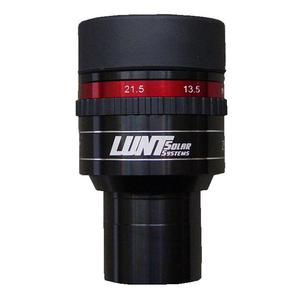The Lunt LS130MT is a telescope for observing the Sun in H-alpha light with a half width of <0.7 Angstrom. It is fitted with a B1200 blocking filter for this purpose.
The real star of the show is its modular construction: You can easily remove the H-alpha filter and use the telescope for night observations. The telescope is also expandable for further solar observation. Use a Herschel wedge for observing the Sun in white light or swap the H-alpha filter for a Ca-K module. You can find both in our accessory recommendations.
So that the telescope can be used versatilely, the lens is higher quality than those typically found on other H-alpha telescopes. It is a triple lens apochromat with an ED element, a colour-corrected lens. The focal ratio of f/7 is especially convenient. It is high-speed but allows even greater magnification. Observing the Moon and planets are particularly enjoyable with such as telescope, meaning the Lunt LS130MT can be described as a solar system telescope.
Observing the starry night sky: The H-Alpha Etalon system can be removed from the telescope in a few easy steps thanks to its modular design. Then the 3-lens apochromatic refractor can be used as a normal telescope with 130mm aperture and 910mm focal length for observation and photography of the night sky. The FPL-53 triplet lens offers an outstandingly low colour aberration image. Common 2 inch star diagonals can be used at the R&P focuser of the telescope.
PT pressure tuner: Fine-tuning on the Etalon filter is provided via an air pressure system. A small change to air pressure within a pressure chamber inside the telescope changes the refractive index of the air, resulting in precise yet effortless adjustment to the H-alpha spectral line. The pressure tuner guarantees a uniform image with no central obstructions and a long-lasting wear-resistant etalon.
The B1800 blocking filter is very well suited to visual solar observation but can also be utilised for solar photography using cameras with a small sensor chip or which use the APS-C format. For cameras with large sensors, a telescope with a larger blocking filter should be used so that the sensor will be illuminated. For solar photography, we generally recommend so-called planetary cameras which work smoothly with this blocking filter.
It not only matters which telescope you buy but also where you buy it. Our additional services:
- We are a leading telescope dealer and know the devices we sell. Our customer service team will gladly help you after your purchase if you have problems with assembly or operation.
- We provide a copy of the 80-page Telescope ABC beginners handbook with every telescope.

